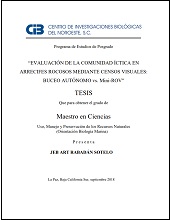| dc.contributor | EDUARDO FRANCISCO BALART PAEZ | |
| dc.contributor | HECTOR REYES BONILLA | |
| dc.creator | JEB ART RABADAN SOTELO | |
| dc.date | 2018 | |
| dc.identifier | http://cibnor.repositorioinstitucional.mx/jspui/handle/1001/1380 | |
| dc.identifier.uri | http://dspace.cibnor.mx:8080/handle/123456789/2733 | |
| dc.description | "El estudio de los peces asociados a arrecifes rocosos en el Golfo de California ha ido en aumento en las últimas décadas, especialmente el de peces conspicuos, con un registro de 333 especies. Sin embargo, se desconoce cómo cambia la estructura de los ensamblajes ícticos con la profundidad, especialmente de la zona mesofótica. Las razones de este desconocimiento se asocian principalmente a las limitaciones del uso de equipo de buceo autónomo SCUBA, cuya profundidad máxima de trabajo y seguridad son los 30 metros. El uso de vehículos operados a distancia (ROV, Remote Operated Vehicle) podría ser una herramienta adecuada para facilitar la toma de datos y subsanar esta carencia de información. Estos aparatos permiten trabajar a mayores profundidades y por tanto caracterizar los hábitats y la comunidad arrecifal, con la ventaja de que tiempo de permanencia y ciclos de trabajos subacuáticos pueden ser indudablemente mayores al de un buceo con equipo autónomo SCUBA tradicional o utilizando mezclas de gases. Sin embargo, la interpretación de la información obtenida debe ser calibrada, a través de un análisis comparativo, con la arrojada por buzos en censos tradicionales de modo de definir las similitudes o diferencias entre ambos, y tener algún criterio objetivo para interpretar los resultados a profundidades donde normalmente no operan los buzos. Para ello se diseñó un análisis comparativo en diversos arrecifes de la Bahía de La Paz, entre censos visuales de transecto con buzos contra los obtenidos con un pequeño vehículo operado a distancia clase 1, tipo VideoRay Pro4. Para la caracterización ecológica de los ensamblajes se utilizaron descriptores comunitarios clásicos (como riqueza, abundancia, diversidad, equitatividad), diversidad taxonómica, así como estadística multivariada. Los resultados indicaron que, en general, se detectó mayor diferencia entre sitios que entre métodos, y que éstas ocurrieron en todos los índices, siendo el sesgo mayor en la abundancia (45.4%) seguido de la riqueza y diversidad (34.8% en ambos índices) y menor en la equitatividad (22.7% con diferencias significativas). Los sitios en Isla Espíritu Santo difirieron más con los aledaños a Isla San José. Entre métodos las diferencias significativas en la abundancia ocurrieron al interior del 40% de los sitios, la riqueza y diversidad mostró diferencias en 33% de los sitios, y no se detectaron diferencias significativas en la equitatividad entre métodos en ningún sitio..." | |
| dc.description | "The study of the fishes associated to rocky reefs in the Gulf of California had been increasing over the last decades, especially in the conspicuous fishes, with a record of 333 species. However, there is a lack of knowledge about how the structure of fish assemblages’ changes with depth, especially in the mesophotic zone. The reasons for this lack are mainly associated with the limitations of the use of SCUBA, whose maximum working depth and safety are 30 meters. The use of remote operated vehicles (ROV) could be an adequate tool to facilitate the collection of data and fill the gaps of information. They allow to work at greater depths and characterize the habitats and the reef community, with the advantage of greater time of permanence and work cycles than that of a common SCUBA diving or using gas mixtures. However, the interpretation of the information obtained must be calibrated with that generate by divers in traditional censuses in order to define the similarities or differences between them and affording to get an objective criterion to interpret the results to depths where divers normally can´t reach. For this purpose, a comparative analysis was designed in several reefs of the Bay of La Paz between underwater visual censuses performed by trained SCUBA divers against a class 1 remote operated vehicle, type VideoRay Pro4. For the ecological characterization of the assemblages, classic community descriptors (such as richness, abundance, diversity, equity), taxonomic diversity, and other multivariate analyses were used. The result of the surveys indicate that the differences were greater among sites than between methods. The differences among sites were mainly in abundance (45.5%), followed by richness and diversity index (34.8%), and minor in equity (22.7% sites with significant differences). The sites around Isla Espiritu Santo were more distinct with that close to Isla San José. Between methods, the main difference in each site was related to abundance (in 40% of the 15 sites), richness and diversity index showed significant differences within 33% of the sites, and no differences in equity was detected between methods in any site. Among depth strata no differences were found in any site..." | |
| dc.format | application/pdf | |
| dc.language | spa | |
| dc.publisher | Centro de Investigaciones Biológicas del Noroeste, S. C. | |
| dc.rights | info:eu-repo/semantics/openAccess | |
| dc.rights | http://creativecommons.org/licenses/by-nc-nd/4.0 | |
| dc.subject | info:eu-repo/classification/AUTOR/ROV, Bahía de La Paz, análisis de ensamblajes ícticos, métodos de monitoreo | |
| dc.subject | info:eu-repo/classification/AUTOR/reef-fish assemblages analyses, monitoring methods | |
| dc.title | Evaluación de la comunidad íctica en arrecifes rocosos mediante censos visuales: buceo autónomo vs. mini-Rov | |
| dc.type | info:eu-repo/semantics/masterThesis | |
| dc.type | info:eu-repo/semantics/acceptedVersion | |

